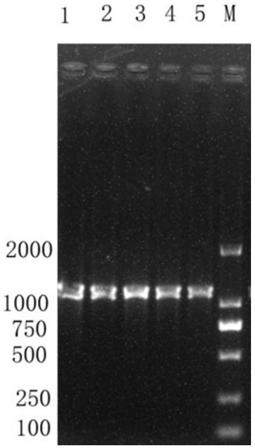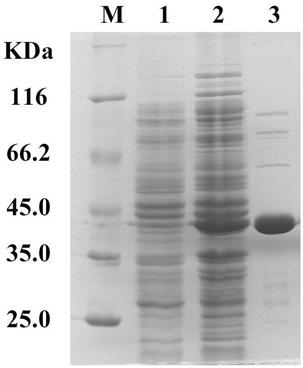6-phosphoric acid-beta-glucosidase and coding gene and application thereof
A technology of glucosidase and phosphoric acid, applied in application, glycosylase, genetic engineering, etc., can solve problems such as less research
- Summary
- Abstract
- Description
- Claims
- Application Information
AI Technical Summary
Problems solved by technology
Method used
Image
Examples
Embodiment 1
[0022] Example 1: Amplification of the thermophilic Bacillus CCTCC No: M2011468 6-phospho-β-glucosidase gene pbgl
[0023] Genomic DNA of thermophilic Bacillus CCTCC No: M2011468 was prepared by conventional methods, and the process can be referred to the instructions of the Takara MiniBEST Universal Genomic DNA Extraction Kit Ver.5.0 kit.
[0024] Design primers to introduce restriction enzyme cutting sites that can be inserted into the EcoRI and KpnI of the plasmid pETDuet-1. The primer sequences are as follows:
[0025] Upstream primer 5'-caccacagccaggatcc gaattc ggtgtgccatttgggacaaat-3' (underline represents EcoRI)
[0026] Downstream primer 5'-cggtttctttaccagactcgag ggtacc ctatgaaaaaatcaatt-3' (underline represents KpnI)
[0027] Using the extracted genome of thermophilic Bacillus CCTCC No: M2011468 as a template, the above primers were used to amplify to obtain the 6-phospho-β-glucosidase gene sequence.
Embodiment 2
[0028] Example 2: Alignment and analysis of the pbgl sequence of the thermophilic bacillus CCTCC No: M2011468 6-phospho-β-glucosidase gene pbgl
[0029] The product obtained by PCR amplification in Example 1 was purified using a Promega purification kit, and sent to a sequencing company for sequencing. Sequencing results showed that the nucleotide sequence of pbgl was 1095bp, as shown in sequence 1 in the sequence listing. The gene encodes a protein with a size of 364 amino acids, as shown in sequence 2 in the sequence listing, with a molecular weight of about 41.7 kDa and an isoelectric point of 6.342. Through NCBI Blast comparison analysis, the protein belongs to DUF871 superfamily (DUF, Domain of UnknownFunction, domain of unknown function), for example, the results are shown in the attached image 3 shown. Most of the reported 6-phospho-β-glucosidases belong to the GH1 or GH4 family of glycoside hydrolases, and their amino acid sequences were compared with the reported g...
Embodiment 3
[0030] Embodiment 3: Construction of the recombinant expression bacterial strain comprising 6-phosphate-beta-glucosidase gene pbgl
[0031] 1. Construction of recombinant plasmid comprising 6-phospho-β-glucosidase gene pbgl
[0032]The product obtained by PCR amplification in Example 1 was purified using a Promega purification kit. The pETDuet-1 plasmid was double digested with restriction endonucleases EcoRI and KpnI, and purified using the Promega purification kit. The above two purified products were ligated at 50°C for 15 minutes using the full gold pEASY-Uni Seamless Cloning and Assembly Kit, and the ligated products were heat-shocked to transform Escherichia coli Trans-T1 competent cells, and coated with ampicillin-resistant plates to screen for positive recombinants strains, and use the universal primers pETUpstream Primer and T7TerminatorPrimer suitable for pETDuet-1 to sequence to determine the positive recombinant strains.
[0033] 2. Construction of a recombinant ...
PUM
| Property | Measurement | Unit |
|---|---|---|
| molecular weight | aaaaa | aaaaa |
Abstract
Description
Claims
Application Information
 Login to View More
Login to View More - R&D
- Intellectual Property
- Life Sciences
- Materials
- Tech Scout
- Unparalleled Data Quality
- Higher Quality Content
- 60% Fewer Hallucinations
Browse by: Latest US Patents, China's latest patents, Technical Efficacy Thesaurus, Application Domain, Technology Topic, Popular Technical Reports.
© 2025 PatSnap. All rights reserved.Legal|Privacy policy|Modern Slavery Act Transparency Statement|Sitemap|About US| Contact US: help@patsnap.com



